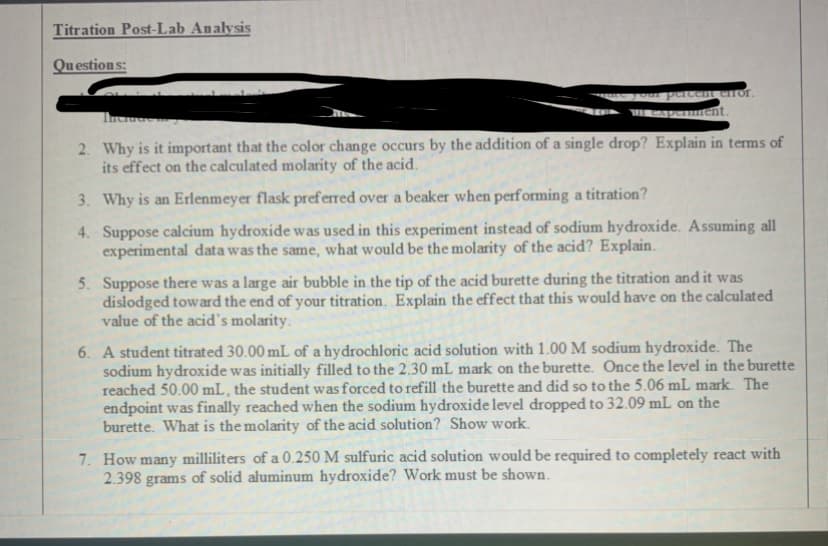estions: our percent enor. ent. 2. Why is it important that the color change occurs by the addition of a single drop? Explain in terms of its effect on the calculated molarity of the acid. 3. Why is an Erlenmeyer flask preferred over a beaker when performing a titration? 4. Suppose calcium hydroxide was used in this experiment instead of sodium hydroxide. Assuming all experimental data was the same, what would be the molarity of the acid? Explain.
estions: our percent enor. ent. 2. Why is it important that the color change occurs by the addition of a single drop? Explain in terms of its effect on the calculated molarity of the acid. 3. Why is an Erlenmeyer flask preferred over a beaker when performing a titration? 4. Suppose calcium hydroxide was used in this experiment instead of sodium hydroxide. Assuming all experimental data was the same, what would be the molarity of the acid? Explain.
Anatomy & Physiology
1st Edition
ISBN:9781938168130
Author:Kelly A. Young, James A. Wise, Peter DeSaix, Dean H. Kruse, Brandon Poe, Eddie Johnson, Jody E. Johnson, Oksana Korol, J. Gordon Betts, Mark Womble
Publisher:Kelly A. Young, James A. Wise, Peter DeSaix, Dean H. Kruse, Brandon Poe, Eddie Johnson, Jody E. Johnson, Oksana Korol, J. Gordon Betts, Mark Womble
Chapter26: Fluid, Electrolyte, And Acid-base Balance
Section: Chapter Questions
Problem 40CTQ: Case Study: Kim is a 38-year-old women admitted to the hospital for bulimia. Her laboratory results...
Related questions
Question

Transcribed Image Text:Titration Post-Lab Analysis
Question s:
our percent enor.
Thee
2. Why is it important that the color change occurs by the addition of a single drop? Explain in terms of
its effect on the calculated molarity of the acid.
3. Why is an Erlenmeyer flask preferred over a beaker when performing a titration?
4. Suppose calcium hydroxide was used in this experiment instead of sodium hydroxide. Assuming all
experimental data was the same, what would be the molarity of the acid? Explain.
5. Suppose there was a large air bubble in the tip of the acid burette during the titration and it was
dislodged toward the end of your titration. Explain the effect that this would have on the calculated
value of the acid's molarity.
6. A student titrated 30.00 mL of a hydrochloric acid solution with 1.00 M sodium hydroxide. The
sodium hydroxide was initially filled to the 2.30 mL mark on the burette. Once the level in the burette
reached 50.00 mL, the student wasforced to refill the burette and did so to the 5.06 mL mark. The
endpoint was finally reached when the sodium hydroxide level dropped to 32.09 mL on the
burette. What is the molarity of the acid solution? Show work.
7. How many milliliters of a 0.250 M sulfuric acid solution would be required to completely react with
2.398 grams of solid aluminum hydroxide? Work must be shown.
Expert Solution
This question has been solved!
Explore an expertly crafted, step-by-step solution for a thorough understanding of key concepts.
This is a popular solution!
Trending now
This is a popular solution!
Step by step
Solved in 4 steps

Recommended textbooks for you

Anatomy & Physiology
Biology
ISBN:
9781938168130
Author:
Kelly A. Young, James A. Wise, Peter DeSaix, Dean H. Kruse, Brandon Poe, Eddie Johnson, Jody E. Johnson, Oksana Korol, J. Gordon Betts, Mark Womble
Publisher:
OpenStax College



Anatomy & Physiology
Biology
ISBN:
9781938168130
Author:
Kelly A. Young, James A. Wise, Peter DeSaix, Dean H. Kruse, Brandon Poe, Eddie Johnson, Jody E. Johnson, Oksana Korol, J. Gordon Betts, Mark Womble
Publisher:
OpenStax College



Biochemistry
Biochemistry
ISBN:
9781305961135
Author:
Mary K. Campbell, Shawn O. Farrell, Owen M. McDougal
Publisher:
Cengage Learning